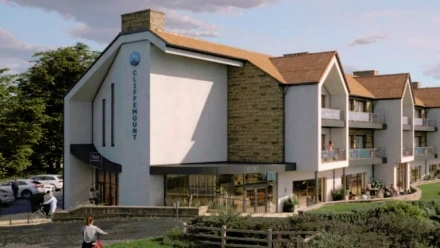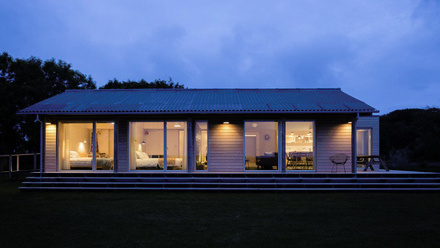Debunking myths around Passivhaus design: separating fact from fiction
Since the world's first Passive House was completed four decades ago in Germany in 1991, the Passivhaus standard has gained recognition worldwide for its promise of exceptionally low energy consumption, high indoor comfort and reduced environmental impact. For the UK, certified projects have risen exponentially in the last ten years from single figures to well over 1000 units today including both new build and the retrofit standard EnerPHit.
With the UK government striving to meet net zero carbon targets, standards such as Passivhaus will become even more common. However, progress has been slow to bring in effective national policies with expectations on the long-awaited Future Homes Standard (FHS) likely to feature Passivhaus in some way. Recent uplifts to Part F and L of the Building Regulations are part of the FHS roadmap but have received some criticism that targeted emission savings are not ambitious enough. The regions, however, have taken up the baton by striving for higher standards, with the Scottish government bringing in legislation that all new buildings from 2024 must "meet significantly higher energy efficiency standards, as well as explicit support for Passivhaus and equivalent standard".
There are also similar commitments elsewhere, with the Welsh government requiring net-zero carbon targets in operation with many Passivhaus-certified schools already built. Northern Ireland is also reaching to achieve zero carbon targets and boasts the world's largest Passivhaus building with the exemplar South West College Erne Campus. In England, local authorities have used their powers to pave the way by embracing Passivhaus with Exeter, to name but one, developing the UK's first Passivhaus leisure centre and public pool.
However, like any innovative concept, Passivhaus design has been accompanied by its fair share of myths and misconceptions. In this article, we delve into some of these myths and provide clarity on what Passivhaus design truly entails.
Myth 1: Passivhaus design is only for cold climates
One of the most persistent myths about Passivhaus design is that it is only suitable for cold climates. While it is true that the standard originated in Germany, where winters can be quite harsh and has been taken up extensively in the Nordic countries, Passivhaus principles can be adapted to various climatic conditions. The core idea behind Passivhaus design is to create an airtight and well-insulated building envelope, which is equally effective in both cold and warm climates. In fact, Passivhaus-certified buildings have been successfully constructed in regions with diverse climate profiles, including hot and humid climates. Passivhaus design pays particular attention to the thermal comfort balance all year round, keeping the heat out in the first place rather than trying to cool the air once it is inside. With the emphasis on good design using external shading, window placement and the mechanical ventilation design it becomes much more resilient during periods of hot weather than conventionally built buildings.
Myth 2: It is hermetically sealed and lacks fresh air
Some sceptics argue that Passivhaus buildings, due to their emphasis on airtightness, may suffer from poor indoor air quality. However, Passivhaus design considers the importance of proper ventilation. In reality, the design incorporates mechanical ventilation systems with heat recovery (MVHR) to ensure a constant supply of fresh, filtered air while recovering the heat from the exhaust air. This maintains a healthy indoor air quality and eliminates the need for excessive air leakage through cracks and gaps, which is common in conventional buildings. Many of the current UK building stock suffers from poor and uncontrolled ventilation, with increased humidity resulting in mould, condensation, dust mites and cold zones causing ill health. MVHR systems continuously exchange stale indoor air with fresh outdoor air while recovering heat in the process, ensuring a constant supply of fresh air without compromising energy efficiency.
Myth 3: It is just about insulation
One of the most common misconceptions is that Passive House design is merely about adding extra insulation to a building. While insulation is undoubtedly a key component, particularly as quality insulation is a very affordable way of saving energy, it is far from being the sole focus.
The core principle of the standard is to achieve an exceptional level of airtightness and thermal performance by meticulously designing the entire building envelope, which includes walls, windows, doors, roofs and floors. This comprehensive approach ensures minimal thermal bridging and a controlled exchange of heat between the indoor and outdoor environments.
Myth 4: Passivhaus design is too expensive
Another common misconception is that Passivhaus construction is prohibitively expensive. While it is true that upfront costs for materials and systems may be slightly higher than conventional construction, the long-term benefits of Passivhaus design far outweigh the initial investment. Passivhaus buildings drastically reduce energy consumption and utility bills, leading to substantial savings over the building's lifespan. Long term studies of certified housing shows residents experiencing very low heating bills which is why the standard is being rolled out across many social housing associations. Additionally, as energy efficiency becomes a more critical factor in real estate valuation, Passivhaus-certified properties tend to command higher resale values.
Myth 5: Passivhaus design is restrictive in architectural freedom
Critics often suggest that adhering to Passivhaus standards limits architectural creativity and imposes rigid design constraints. However, Passivhaus design principles are flexible and can be integrated into various architectural styles. It involves careful analysis and modelling of each individual project to optimise its energy performance while adhering to the core principles. From single-family homes to office buildings and schools, the Passivhaus approach can be customised to meet the specific requirements of each project. The focus is on optimising the building envelope and energy performance, leaving ample room for innovative design solutions. Architectural Technologists and designers can still exercise their creativity while achieving the core energy-efficiency objectives.
In conclusion, Passivhaus design has emerged as a groundbreaking approach to sustainable construction that challenges traditional norms. While misconceptions have occasionally clouded its reputation, a closer examination reveals that Passivhaus principles are adaptable, promote indoor comfort, and offer long-term financial and environmental benefits. As the construction industry continues to embrace eco-friendly practices, Passivhaus design stands as a beacon of innovation, dispelling myths and paving the way for a more sustainable future.
This article first featured in AT Journal issue 148





